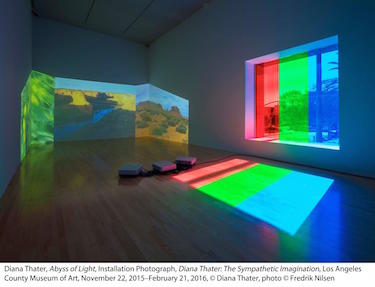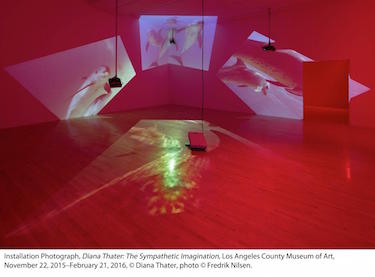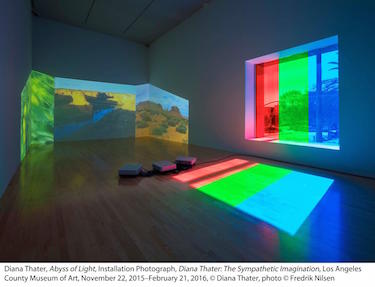Video Art Via Video Tech: Sony Projectors Support LA County Museum of Art


Diana Thater is known for creating works of art that re-define the physical, and conceptual boundaries of how moving images are experienced. So it’s fitting that the artist’s latest exhibit, “The Sympathetic Imagination,” uses Sony laser projectors, since that technology was designed for the same purpose.
‘The Sympathetic Imagination’ exhibit ends its run in April at the Los Angeles County Museum of Art (LACMA) and is a prime example of video art meeting video technology.
The exhibit uses 35 Sony projectors a combination of laser models (VPL-FHZ700L and FHZ55) and lamp-based units VPLFX30 models). Based on the visitor response and the feedback from the museum¹s team, the two mediums were the right fit.
“For more than two decades, Diana Thater has been creating groundbreaking installations that use the visual language of film and video to push the boundaries of how moving images are displayed,” said Christine Y. Kim, exhibition co-curator and associate curator of Contemporary Art at LACMA. “Her pioneering oeuvre integrates architecture and the natural environment, using applied color, and artificial as well as natural light to explore the artifice of its own production.”
According to Kim, “The Sympathetic Imagination” is the most comprehensive exhibition of her art to date, giving visitors an opportunity to see an important selection of her film, video, and installation-based works. To convey these themes in the best setting possible, LACMA searched for the right physical space (since this is the largest exhibition dedicated to a female artist in LACMA's history) and the right technology.
“It was very clear early on that we needed appropriate gallery square footage for these large-scale works,” said Kim. “Likewise, given that her work attempts to unpack vocabularies and materials of video such as the creation of image through the color palette of RGB, CMY, and because her primary mode of display involves projections and monitors within architectures of different shapes and sizes, it was clear that we needed to focus on equipment and have all the options and capabilities with that equipment to best display her brilliance.”
The LACMA team identified several specific technology requirements to match the exhibit’s unique aspects.
A daily selection of the top stories for AV integrators, resellers and consultants. Sign up below.
“Diana's works in this exhibition range from single-display standard definition works to custom-resolution multiple projector works,” said Patrick Heilman, Gallery media manager at LACMA. “Gallery sizes and projector mounting systems also varied dramatically, requiring projectors in some cases to be simply small and light, while in others-- comprehensively featured and powerful.”
LACMA’s approach to new technology is to understand, from a curatorial perspective, the context and expertise employed in an artist’s work.

“Many artists working today are using digital technology in the form of computers, animation, Photoshop, projections, editing, etc., during the production and the exhibition processes,” Kim said. “In terms of presentation, it's imperative to find the best and most appropriate equipment to fully articulate and exhibit work and images as they are intended by the artist in concert with the gallery's architecture, movement, visitors, etc. That's always an exciting challenge.”
The choice of Sony projection was based on the exhibit’s objectives, and Heilman and his team found it helpful to be able to choose from a range of technology types.
“Sony offers traditional lamp-based projectors and laser models,” said Heilman. “We're using both technologies for this exhibit, as determined by budget and specific use case. For us, that delineation is essentially the lamp-based units for the earlier works, for which we're using more than twenty FX30's, and FHZ55 and FHZ700L laser models for the large-scale works.”
Lens selection and quality were also essential criteria in determining how the team would use technology for this show, since Thater’s works marry technology to architecture in ways that can require very exact and/or extreme throws.
Additionally, beyond initial tech requirements and installation, it was important that the equipment be durable and user-friendly, since the exhibit will tour to other institutions with other gallery installation teams.
To make “The Sympathetic Imagination” really come to life, the LACMA team put the edge-blending feature of the Sony projectors to the test. Edge blending is the technique of taking multiple images and "weaving" them together to create one large image, especially useful in challenging lighting environments.
“We installed two larger scale works in BCAM that required higher output projectors that could take very wide angle lenses-- both fixed and zoom,” Heilman said. “Sony had exactly the spec we needed to accomplish each of those installations. In the case of A Cast of Falcons [an artwork featured in “The Sympathetic Imagination”], we had initially considered hanging the four edge-blended projectors from the ceiling structure, but later in the process, upon weighing a number of competing factors, we determined that the benefit of the stability of a shelf mount from the back wall trumped all other factors. The VPLL 4008 lenses, hosted by the suite of FHZ770L's provided the optically solid base from which to seamlessly activate the 100 foot wall with Diana's large scale panning bird imagery.”
The LACMA team also used Sony's FWD-46B2 monitors for Thater’s single- and multi-channel flat panel display based video works.
“The clean, design, symmetrical bezel, coupled with excellent build and image quality provided the ideal framework to support and favor the image, while elegantly staying out of the way,” said Heilman. “I'm really happy with the results we've achieved with our Sony/LACMA partnership for this exhibition.”
